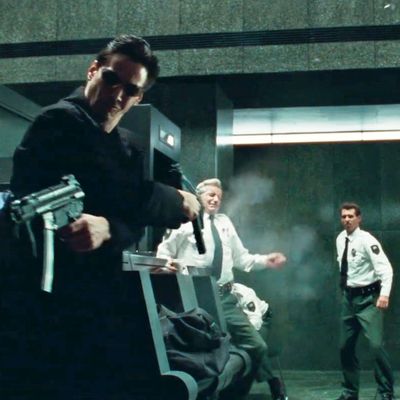
It’s always specious to seek the cause of real-life murder in a killer’s pop-culture fascinations. At the same time, it’s disingenuous to insist that the rise of mass shootings in America has nothing to do with the prevalence of badass kill squads on our screens. First-person shooter games and gun-fetishizing action movies likely don’t create killers — but, disturbingly, they can give them tips for style.
The Matrix hit theaters in March of 1999, thrilling audiences with, among its other qualities, a climactic vision of a trench-coated Neo (Keanu Reeves) and Trinity (Carrie-Anne Moss) gunning down security guards and dozens of first responders in the lobby of an everyday office building. The film assures us that the victims aren’t real people — this massacre takes place, of course, inside the shared dreamworld of “The Matrix.” But the sequence’s power comes from the ordinariness of its setting, from the dreary ritual of passing through a security checkpoint, from the way the faces of schlubby rent-a-cops monitoring the metal detector go from boredom to terror as they’re abruptly killed.
From there the film leaps into its most viciously alluring power fantasy — and what might be its most broadly influential scene. A battalion of guards in gear suggestive of SWAT teams floods into the lobby, and Neo and Trinity blow them all away. The killing is balletic, cathartic, depicted in fluid slow motion, the heroes moving more like models on a runway than shooters facing death. Neither breaks a sweat or exhibits any emotion other than a look of slightly perturbed professionalism. It’s slaughter as squad walk, a violation of the unwritten adventure-movie rule not to make murder look heroic. Despite all its in-film justification, the scene insists there’s nothing more awesome than striding into a place of business and opening fire on any working stiff who had the temerity to show up that day.
Two decades later, that invasion scene remains exciting, upsetting, and just a touch goofy. (As the guards fire back, Neo turns cartwheels, which probably doesn’t actually help avoid bullets.) What’s perhaps most shocking now is The Matrix’s turned-on enthusiasm for the guns, which the Wachowskis emphasize as giddily as Russ Meyer would breasts. In The Matrix, the bullets get more screen time than the people they kill. Its logic holds that the people aren’t quite real — at least not as real as those torrents of discharged shell casings.
Less than a month after The Matrix’s opening, Eric Harris and Dylan Klebold killed a dozen of their classmates and one teacher at their high school in Columbine, Colorado. Because the boys favored trench coats and violent video games, some pundits in search of easy causation blamed The Matrix and Doom and whatever other entertainments that white teen boys relished but parents deplored — entertainments that invariably depicted the heroic killing of not-quite-real enemies. It’s impossible to say that The Matrix inspired the Columbine shooting or any of the many school and workplace shootings that followed; Klebold had first noted the idea of a killing spree in his journal as early as 1997. But it’s also impossible to say that The Matrix did not offer an imaginative framework for the idea, or that the awesomeness of its murderous squad walk was not an inducement.
It’s a rarity in contemporary studio films, a sequence so brazenly, breathlessly irresponsible that, while watching it, you’re likely to gape that it played in every multiplex in America. Its techniques have been relentlessly imitated in Hollywood ever since, but its content, and its disquieting moral ambivalence, have proven less influential. In fact, no studio blockbuster would dare anything quite like it again. Even the giddily bloody Kingsman films make the case in each scene that their corpses deserve to be corpses.
Understandably, Hollywood has been loath in the years since to give us scenes of heroes shooting what appear to be everyday Americans.
(That qualm isn’t new, of course — recall the second Terminator film, in which the time-traveling murder bot, now the good guy, compromises by only aiming for police officers’ knees.) But The Matrix was too huge, too cool, too seductive not to imitate. The movies still relentlessly chase the high of that notorious sequence, with can-you-top-this? massacres in every proudly disreputable Deadpool or Kick-Ass or Equalizer.
More pressingly, you see it in the PG-13s. There couldn’t be an Avengers franchise as we know it without the example of the Wachowskis’ staging, camerawork, EDM scoring, and slow-mo celebration of slickly violent teamwork. Superheroes pose, stride, and ka-pow in imitation of the Wachowskis’ own imitation of the visual language of comic books. But they do so without guns, usually without killing, and never against what appear to be everyday people — it’s always robots or aliens, orcs or stormtroopers, or some other not-quite-human ass audiences can cheer the kicking of.
Everything trenchant in the Wachowskis’ original vision is, in these housebroken derivations, now all-American wholesome. They’re slaughters you can feel good about. That might be healthier for us as a society, since watching Thor smash the intergalactic beasties on the Rainbow Bridge certainly does not help an unsettled mind in assembling the imaginative framework for a potential real-world massacre. At the same time, such bloodless, gunless, personless violence, waged with what George W. Bush used to call “moral clarity,” relieves us from facing the disturbing question that underpins The Matrix’s massacre: What happens when a society infatuated with heroic violence offers disturbed young men no robots or aliens to punch — but does provide them easy access to guns?
More From This Series
- The Beatific Imperfection of Keanu Reeves in The Matrix
- How The Matrix Got Made
- The Matrix Taught Superheroes to Fly

